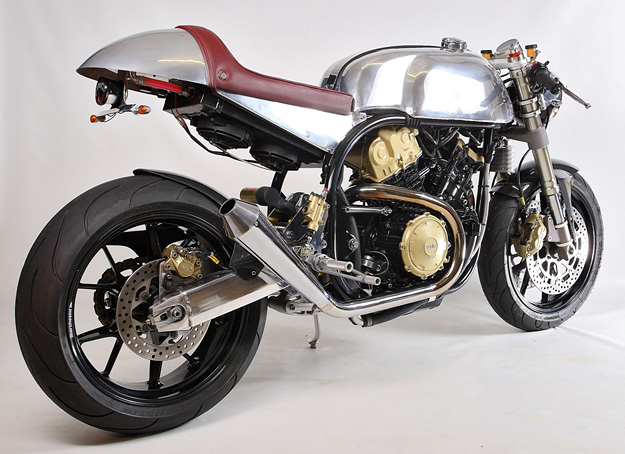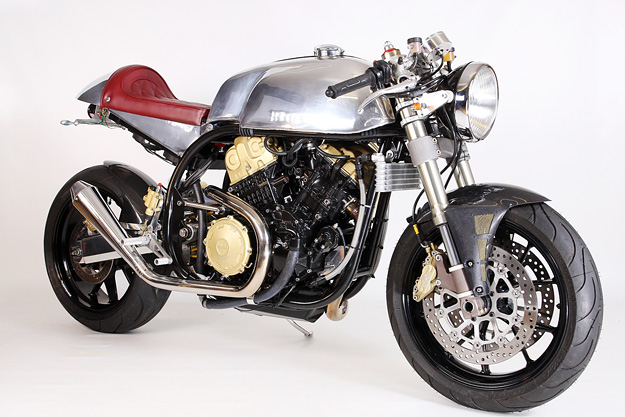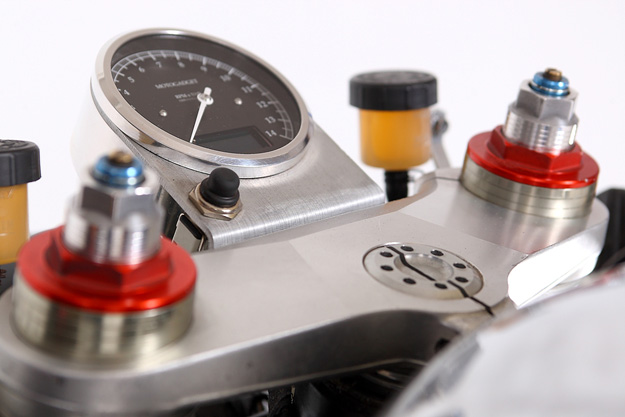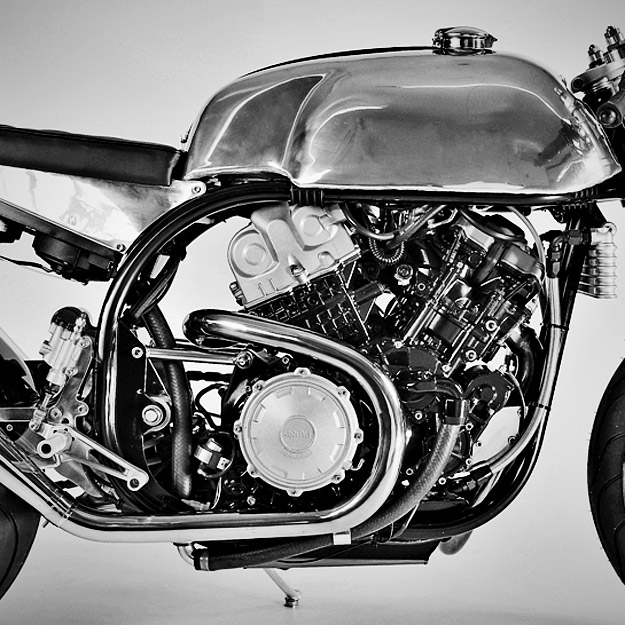
Most café racers are built by stripping down a stock bike and “adding lightness”. This one, however, was built from the ground up and designed around an Aprilia RSV motor. It’s from Taimoshan Cycle Works, a Welsh company run by John Pellew. He focuses on “building cafe racers with a steampunk feel—classic racer designs underpinned with modern technology.”
John started by spending hours hand-drawing the bike, with all its lines and components, then searched high and low until he found the right parts. And when parts were not available, John designed and built them himself. The motor was the starting point: “I spent months looking in detail at the aesthetics of the 1000cc V-twins available on the market … What I was trying to achieve was my version of the Norvins of the 1960s, but with all the good bits of modern tech, like big horsepower, fuel injection, big brakes, good handling, electric start and so on.”
The challenge was that modern V-twin sport bike motors are water cooled, and have big, ugly radiators to deal with. John chose the RSV Aprilia motor (made by Rotax) because it it’s good looking, technology-rich and “a well-respected beast of a motor with an almost cult following.”

After designing a frame to house the motor, John got JW Motorcycles to build it. It’s a featherbed-style frame that hooks up to a mono shock rear suspension. The swingarm was built with the help of engineering guru Steve McFarlane, and the tank was next. “I originally wanted the Norton sprint tank,” says John, “but it was a stretch too far when trying to fit in the electronic fuel injection components. “So I opted for the much bigger Manx tank, which turned out perfect—and probably a more striking design too.”

The stainless steel exhaust was made in-house: “I ordered a stack of stainless pre-bent tube, and spent a couple of days cutting and tacking it all together so that both pipes are identical length and also finish at the same point.” The pipes were loud, at around 113 db, so John tweaked the inners of the reverse megaphones and repacked them, reducing the noise down to around 97 db—under the 99 db limit for the UK.

The radiator is mounted under the seat, and apparently works well. “The cooling fans are standard … they draw a huge amount of cool air from around the engine into the front of the wedge, and of course all the hot air is blown down and away from the seat. So the seat temp is quite normal.” The last big piece to the puzzle was the electronic ignition and fuel injection: “The racers use the standard ECU with a Power Commander, so they don’t need to know any of the info. Reverse engineering the engine parameters and spark and fuel mapping took months of work. Even a well-known race dyno shop gave up on it, and handed it back in far worse shape. But now, after hundreds of hour of fine tuning, the bike is running very sweetly, with sharp throttle response and a smooth power curve.”
Now that the Aprilia RSV Super Cafe Racer is finished, John has some other very interesting projects on the go, including two carbon fiber framed Triumph Bonneville prototypes. There’s also a Vincent racer called “Nero Superleggera”—built around an original 1955 Vincent Rapide Series C and a high performance 1356cc new build Vincent race motor. That bike will also feature an improved geometry ‘girdraulic’ front end with 6-pot AP racing calipers acquired from an Isle of Man TT racer. Keep an eye out for that one on Bike EXIF later in the year.
